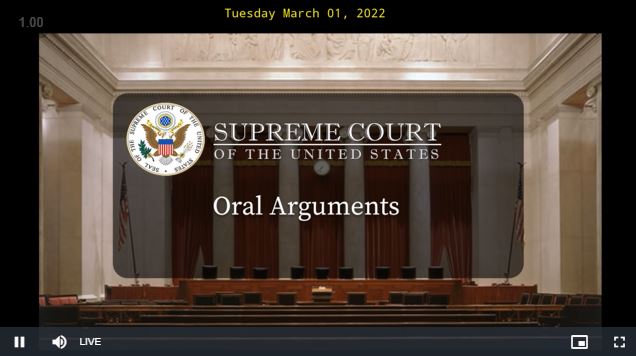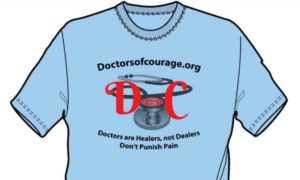Ron Chapman II wrote a succinct explanation of the Supreme Court hearing for the Doctors Xiulu Ruan, MD and Shakeel Kahn, MD in his blog. He has given me permission to share his blog post. But also, please go to his original blog as that will help his search engine ratings as well. Thank you, Ron, for allowing us to share.
Ron Chapman II’s Post:
The Supreme Court heard oral argument today in the most important healthcare case since 1975, Ruan v. United States . While we were hoping for a glimmer of justice, what we got was a dizzying lesson on grammar, parsing of words, and speed limit analogies. But Justice Gorsuch in his gentle, fatherly cross examination style attempted to bring the argument for petitioners back on track by showing the nonsensical and circular nature of the Government’s argument.
This issue before the Supreme Court is thoroughly addressed here and if you aren’t familiar go back and read that article first.
Before we get into the oral argument its important to understand the changes in the case prior to the parties taking the podium. The issue before the 11th Circuit was the failure to give a “good faith” instruction which essentially permitted the Government to convict Ruan under a strict liability standard. The 11th Circuit believed that if his conduct failed to comport with the objective requirements of the practice of medicine then he should be convicted. Petitioners argued that if he subjectively believed he was following objective standards then he should be acquitted. The Government, straying from the 11th Circuit’s opinion pivoted in their opening brief and said that the physician must make an “honest effort to comply” with the objective standard of practice. This is where the train left the tracks. As Ruan’s counsel pointedly argued – the Government’s argument is a malpractice standard gussied up as an objective standard. The Government pivoted so hard that their argument appeared to turn in the direction of the petitioner, arguing that a subjective “honest effort” is enough. But instead of seizing on that juicy opportunity the justices questions sped past the issues at the heart of the case and turned into a confusing digression into the statutory elements of the offense.
I’ll explain.
THE INTENT COMPONENT
21 U.S.C. 841(a) is a drug trafficking statute. It basically says that its unlawful to knowingly and intentionally distribute controlled substances. But an exception exists in the statute for licensed practitioners. Doctors, pharmacists, and other prescribers and dispensers are exempt from the statute as long as their conduct is “for a legitimate medical purpose in the course of professional practice”. In order to address whether the “good faith” of a physician is relevant the court needed to answer a threshold question and that is whether the intent requirement of the statute applies to the distribution or the exception. Thus, the question is: Does the government need to prove that the doctor knowingly and intentionally distributed drugs or does the government have to prove that the doctor knowingly and intentionally prescribed “outside the course of professional practice and for other than a legitimate medical purpose”. If the government needs to prove only that a physician intended to prescribe drugs then the only doctor who escapes this element is one who prescribes in a coma – as Ruan’s counsel pointed out.
And so the court debated, for some time, whether the intent of the statute was to incorporate the prescriber’s exception as an element of the offense or an affirmative defense to the crime. If its an element, the the intent component must apply to the exception if its not then the intent component only applies to the distribution. Justice Alito seemed to think that the intent element is only related to the distribution and Gorsuch seemed to think that its related to the prescriber’s exception. The other justices didn’t offer much of a position but it seems that Breyer and Alito favor applying it to the distribution because failure to do so creates a statute with two separate intent requirements – one for prescribers and a separate for the general public. Breyer and Alito likely believe that such a reading frustrates the intent of congress in creating the statute.
ONE GLARING OMISSION
But in all of the heated debate surrounding the statutory text of the Controlled Substances Act, the Court and the parties missed the most important issue in the case, and all physician prosecutions. Both the Government and Petitioners conceded in their briefs that the standard applied in such cases is an objective standard of practice- which is incorrect. Both United States v. Moore and Gonzalez v. Oregon clearly state that the Federal Government lacks authority to regulate the practice of medicine. The Government only has authority to punish physicians who act so flagrantly that their conduct can be seen as “drug pushing”. And so, the Government’s proof that a physician’s conduct departed from some sort of “objective standard of care” amounts to mere malpractice and something for State Boards to consider – an issue hinted at in Justice Thomas’s final question. Petitioners should have taken the position that the standard of care is relevant in physician prosecutions only to show the jury the reasonableness of the physician’s conduct but in order for the government to fully satisfy the elements of 841(a) they must prove that a physician’s conduct departed so far from the practice of medicine that they ceased practicing medicine at all.
For more on that point read my article “7 Dirty Words”.
Instead of arguing this federalist argument, the parties were landlocked by the fact that the court granted Cert on the “good faith” issue which necessarily requires an argument regarding the intent elements instead of elevating above this crucial digression and discussing the authority of the Controlled Substance Act to regulate the practice of medicine generally.
Tying an objective standard of care to the elements of an 841(a) violation is dangerous because (1) there is no consensus on what that standard actually is in the medical community, (2) it requires juries to grapple with complex and ever changing medical topics, (3) it allows the government and DEA to drive the standards of practice through CDC guidelines, “red flags”, DEA administrative decisions, and other unpromulgated guidance documents. This is dangerous because either subjectively or objectively the parties have permitted the government to take the position that violation of an invisible and ad hoc standard is sufficient for conviction in the first place.
PREDICTION OF THE COURT’S DECISION IN RUAN V. UNITED STATES
Predicting the outcome of a pending supreme court case is a bit like predicting the weather 30 days out – it ignores the dynamic interplay of the politics of the court. But I’ll take a stab. The Government abandoned the 11th Circuit’s rationale and the Court has no choice but to reverse the 11th Circuit and permit a good faith instruction or at the very minimum a proper instruction on the intent component of an 841(a) violation. It seems that at least five justices agreed with the fact that the intent requirement relates to the prescribers exception: Barrett, Gorsuch, Kavanaugh, Thomas, and Roberts. I think there are enough votes for reversal. But the tougher question is what relief, if any, can be afforded to doctors in the future given that both sides seemed to agree that an objective standard of practice is the standard in interpreting the phrase “legitimate medical purpose”. Kavanaugh seems to take the position that the statute is vague in the first place and may offer a concurring opinion and discuss vagueness unless he can pull the other four in his direction. But I don’t think he will be successful because of the politics of the Court. Determining that 841(a) is vague as applied to physicians will disrupt the balance of justice and require reversal of a lot, actually a ton, of convictions. And one thing we know about the Supreme Court is that it doesn’t favor such sweeping changes. Now this problem was set up by the Court in the first place in failing to address the statutory text since it was first enacted. Since 1975 we have been left without the voice of the court on this statute allowing the circuits to take differing interpretations and circuit splits as they grapple with the statutory text that was most likely written by a congressional staffer in 1970. But I do expect at least some comment on vagueness.
In sum, I expect Ruan and Khan to get some sort of relief from this decision because the jury instructions in their case mis-applied the intent requirement of the statute and made drug trafficking a strict liability offense (like speeding) as applied to physicians. But I don’t expect a sweeping change here, I expect a tailored attack on the 11th Circuit’s reasoning and I expect that the Circuit Courts will pigeonhole the Supreme Court’s decision to prevent its broad application to all physicians convicted under the statute.
There is some good news, potentially, on the horizon though. The Court has held the case of Naum v. United States pending the outcome in Ruan. This is a case where the federalism argument is very much alive. Its a case I have personally handled and if Cert is granted I will be arguing before the Supreme Court. We don’t know why Naum was held by the court but its likely because the Court didn’t want to address the federalism argument until it first decided the more minor issue of good faith and its application to the statutory text.


Trackbacks/Pingbacks